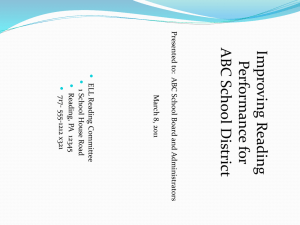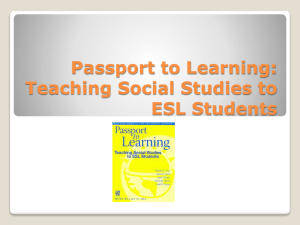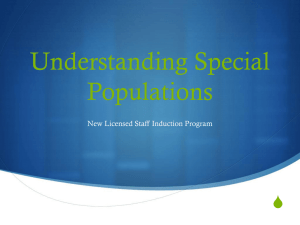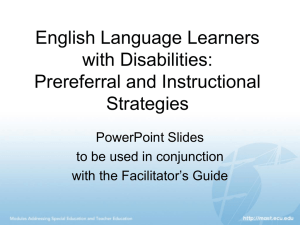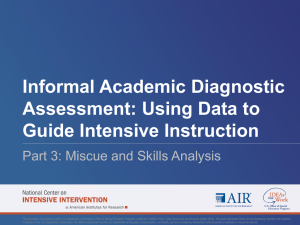Promising ELL Practices - Towson University
advertisement
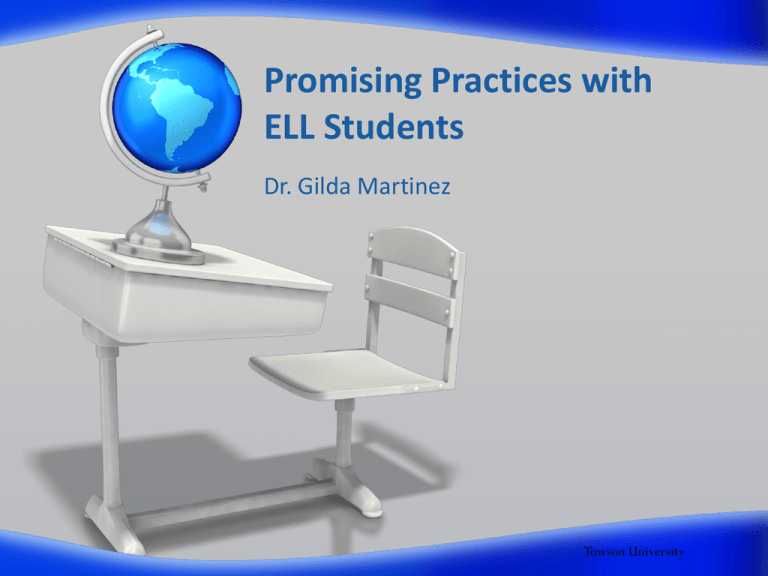
Promising Practices with ELL Students Dr. Gilda Martinez Towson University Maryland TESOL http://www.marylandtesol.org/ These are supposedly real notes written by parents in the Memphis school district. Spellings have been left intact. 1. My son is under a doctor's care and should not take PE today. Please execute him. 2. Please exkuce Lisa for being absent she was sick and I had her shot. 3. Please excuse Gloria from jim today. She is administrating. Second Language Literacy Panel: Preface • Significant increase in immigrant students • 4.6 million ELL students – according to the U.S. Census • ELL lag behind native English speakers in school •Components of Literacy • Same as from the National Reading Panel • Adjustments • Oral in instruction should be made language development should be provided “Fab 5” of NRP • Do you know what they are? Fab 5… • Phonemic Awareness • Phonics • Vocabulary • Comprehension • Fluency Research for ELL • Very limited • More descriptive in nature • Less focused on tests • Less focused on instruction More research on ELL…is NEEDED! • to replicate what has been done • to investigate what other practices work for ELL Phonemic Awareness and Phonics Issues for ELL • Sounds differ in languages • Graphemes • Unfamiliar can have different sounds in L1 phonemes and graphemes make decoding and spelling difficult Phonemic Awareness and Phonics Research • Similar to native speakers, phonemic awareness and phonics instruction helps develop reading skills • Same • This tasks can be used to teach it instruction can take place while learning English Phonemic Awareness and Phonics Assessment • Pronunciation differences should not be counted as errors (such as with the Reading Miscue Inventory or RMI) • Speed and accuracy should be assessed •RMI Purposes • Notes reading strategies • Looking at patterns of miscues • Looking at quality not quantity of miscues • Retelling to note comprehension RMI Procedure • Pick a text you are reading in class (have a copy for yourself to write on) • Write down the miscues • Have student retell what they read • • use outline as a check list Encourage further comments (such as, “What else? Hmmmm.”) • Analyze miscues for patterns (20-25 miscues) • Tape record all of the above Coding for an RMI • • • • • • • • • • • • • Unsuccessful correction Dialect or language variations Non-word substitutions Intonation shift Pauses Repeated miscues Substitutions Omissions Insertions Repetitions (read correctly) Self-corrections Reversals Partial miscue UC d $ / p RM write substituted word above circle word omitted carrot R C dog ate dash after partial word What is a miscue? • Substitutions • Omissions • Insertions • Reversals • Intonation that change grammar • Unsuccessful corrections • Dialect that change grammar • Skipped lines (count as one miscue) What is NOT a miscue? • Repeated miscue (making the same miscue later in the text for the same word) • Repetition of text that is read correctly more than once • Pauses • Pronunciation RMI Listening Time…University of North Carolina http://www.learnnc.org/lp/editions/readassess/1083 PRACTICE TIME! RMI helps teachers develop what skills? RMI helps teachers develop students’… • Reading skills…of course. • Pronunciation (Abuela – entendia todo) • • Listening • • You come across many academic vocabulary words (or more elaborate vocabulary by reading than through conversations) that you can practice learning the correct pronunciation and meaning too Students can listen to their tape recording to hear themselves or their peers to have discussions Speaking • Having conversations with peers about readings helps build speaking skills and reading comprehension Fluency Issues for ELL • Fluency embraces both word recognition and comprehension • ELLs do not get enough opportunities to read aloud in English while receiving feedback Fluency Research with ELL • Too few studies with ELL • Fluency training appears to similarly benefit English speaking and ELL students Fluency Assessment • We do not know if benchmarks for L1 are appropriate for L2 based on the research that exists • Well….we know that it is not. The SLL Panel said they could not determine it based on the research. • Studies do indicate that with intervention, ELLs can reach benchmarks for English speakers More ways to develop fluency, speaking, and listening skills too: • Singing • Reader’s Theatre • Partner reading • Keep talking to them ;-) • Digital Stories (coming up later) Vocabulary Issues • ELLs arrive at school with very limited basic English • They may be able to name objects or concepts in their native language, but not have the vocabulary word to name it in English Vocabulary Issues • Some vocabulary may be especially important in comprehending connected text, this requires explicit instruction, such as: then, second, third • If cognates exist between languages, it is beneficial to teach them • Words with multiple meanings can be confusing Vocabulary Research • Very little here • Should early begin explicit vocabulary instruction Vocabulary Assessment • No specific words have been noted for ELL instruction for different age ranges • Therefore, the panel suggests assessing vocabulary from the curriculum • Depth of word meaning should also be assessed Read-Write-Think for VOCABULARY BUILDING http://interactives.mped.org/view_interactive.aspx?id=127&title= Visuword • This link provides webs for vocabulary words. Check it out! • http://www.visuwords.com/ Coxhead Academic vocabulary • http://www.uefap.com/vocab/select/awl.htm Comprehension Issues for ELLs • Limited vocabulary impedes comprehension • Structural differences of languages can be confusing • Background knowledge will vary Comprehension Research • Very little here…hmmm • Need to focus on strengths and needs of ELL Comprehension Assessment • Many do not provide guidance for instruction based on the assessment results Before, During, and After Reading Strategies… What are they? Before Reading: • Activating background knowledge • Investigating text structure • Setting a purpose for reading • Predicting text content • Reviewing and clarifying vocabulary During Reading: • Establishing the purpose for each part of the reading • Self-monitoring • Visualizing • Summarizing • Confirming/rejecting predictions • Identifying and clarifying key ideas After Reading: Assessing if the purpose for reading was met • Paraphrasing important information • Identifying the main idea and details • Making comparisons • Connecting • Drawing conclusions • Summarizing • Analyzing • PRACTICE TIME! Professor Garfield – Check it out! http://www.professorgarfield.org/pgf_home.html English-Zone.com • http://english-zone.com/index.php In the Book http://reading.ecb.org/ Check it out! Practice with Mike – Check it out! http://www.eslfast.com/robot/english_tutor.htm Three Tiers of Instruction http://www.texasreading.org/3tier/levels.asp • Beneficial for ELL and native English speakers • Need • Need to monitor progress to provide additional support where necessary •Three Tiers •A Primary: Tier 1 Secondary: Tier 2 Tertiary: Tier 3 core reading program with phonemic awareness, phonics, fluency, vocabulary, and comprehension •Progress monitoring a benchmark tests at least three times per year (fall, winter, and spring) •Ongoing professional development •Supplementary program for small groups that are not progressing enough •Students still struggling get more tutoring time and smaller groups Building Language Proficiency • Need to build language proficiency during reading block • Additional time is probably necessary • Embedding this into content instruction builds content knowledge and language Bottom line… • To improve LAS Links scores, you must test prep • Use the ideas suggested already, AND also use similar formatted questions including bubbles, etc. • Use the LAS Links Instructional Guidance bubble sheets you have Use survey monkey to make bubbly activities! Survey Monkey – Check it out! http://www.surveymonkey.com/MySurvey_Wizard.aspx Time for Digital Stories! YAY!!!!! TED Talks • The TED conference brings together people from three worlds: Technology, Entertainment, and Design. Sugata Mitra's Experiments in Self-Teaching: • http://www.youtube.com/user/TEDtalksDirector#p/ u/10/dk60sYrU2RU • • As you watch the video, think about how this relates to your ELL students. Questions: 1. What did you learn from his research? 2. How does this relate to teaching ELL? My thoughts on the matter… • Repeated modeling of proper pronunciation helps teach proper pronunciation • the students taught the computer to record their voice, but had to learn how to pronounce words by listening to the computer • Independent reading helps build English and content skills • the students learning science My thoughts on the matter… • Encouraging students by asking questions promotes further discussion, investigation, and learning • The grandmother method • Working in groups help students remember info • Use technology – it is very motivating for learning! Upcoming TED Event: • TEDxMidAtlantic 2010 will be held on November 5 at Sidney Harman Hall in Washington, DC • Information: • http://tedxmidatlantic.com/event-details/ • Registration: • http://tedxmidatlantic.com/registration/ Teaching Diverse Learners http://www.alliance.brown.edu/tdl/tlstrategies/index.shtml • What did you think is helpful? What will you do? Maryland TESOL http://www.marylandtesol.org/
